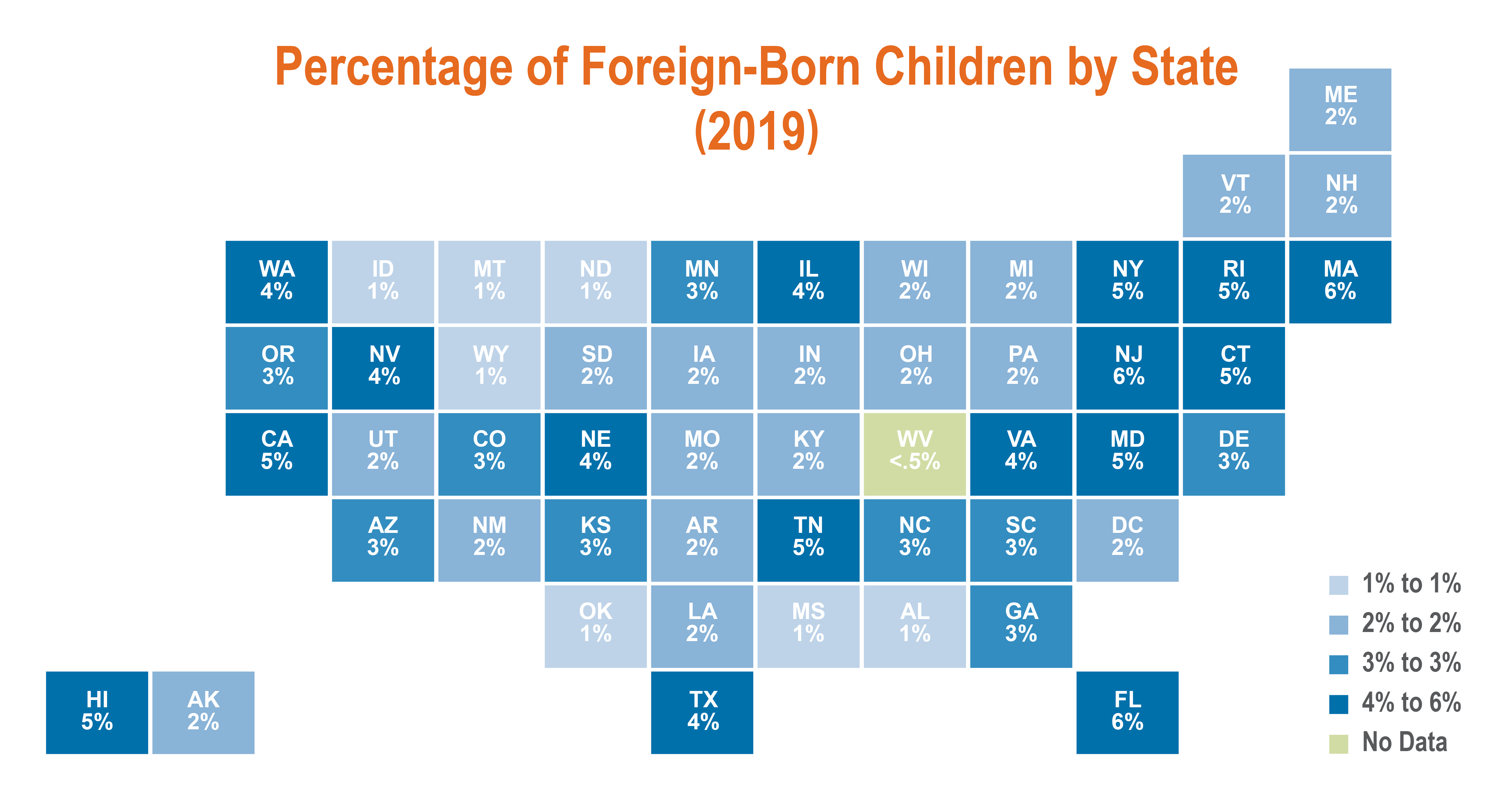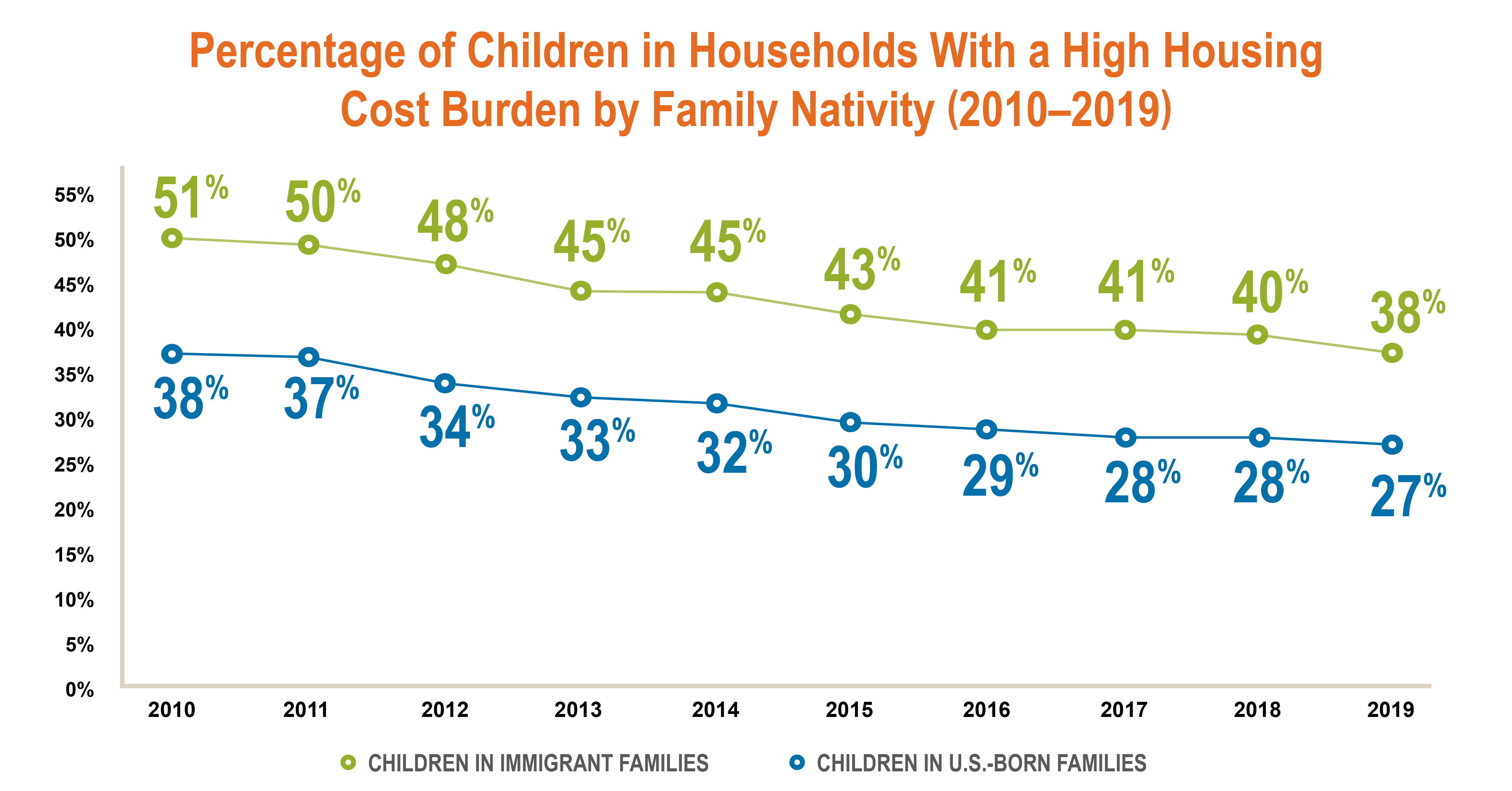If My Baby Is Born in Usa Is It a Citizen 2019
In recent years, children in immigrant families regularly have been at the center of major public policy discussions, such as those regarding the southern border of the United States and the Deferred Action for Childhood Arrivals policy, among others. To promote an accurate understanding of this population and constructive conversations about how to support these children and their families, it is important to understand basic terminology and key facts about this group in the United States.
Definitions About Children in Immigrant Families
Immigrant or Foreign-born
The terms immigrant and foreign-born are interchangeable and refer to individuals who were not U.S. citizens at birth but may have become citizens through naturalization. Those who are not citizens may include lawful permanent residents, those with temporary visas, refugees and asylum seekers or unauthorized immigrants.
U.S. Citizens
Citizenship usually is acquired when a child is born in the United States, Puerto Rico, Guam, the U.S. Virgin Islands or the Northern Marianas or born abroad to American parents. Citizenship also can be obtained through the naturalization process.
Naturalization
The process in which a lawful permanent resident becomes a U.S. citizen after meeting requirements in the Immigration and Nationality Act.
Lawful permanent residents (also known as "green card" holders)
This permanent status may be obtained through multiple methods, including family relationships, employment sponsorships, humanitarian protection (for refugees and asylum seekers) or the Diversity Visa Program lottery.
Asylum Seekers and Refugees
These are individuals who need protection due to persecution or fear of persecution "on account of race, religion, nationality and/or membership in a particular social group or political opinion." Asylum seekers submit applications at a port of entry to the United States or when they are already in the country, while refugees are outside of the United States when they are considered for resettlement.
Unauthorized (Undocumented) Immigrants
This term refers to foreign-born individuals who are not citizens and not legal residents. This includes people who entered the United States without inspection and those who were legally admitted on a temporary basis but stayed beyond their required departure date.
Migrants
Generally, a migrant refers to someone who changed his or her country of usual residence regardless of the reason. It may be voluntary or forced migration, and it may be temporary or permanent.
Nativity
Nativity refers to whether individuals are native-born versus foreign-born. Native-born is defined as born in the United States, Puerto Rico, Guam, the U.S. Virgin Islands or the Northern Marianas or born abroad to American parents.
First-generation Immigrant Children
This term typically refers to foreign-born children with at least one foreign-born parent.
Second-generation Immigrant Children
This term typically refers to native-born children with at least one foreign-born parent.
Children in Immigrant Families
Generally, this term includes both first- and second-generation immigrant children.
Key Facts About Children in Immigrant Families
How many children are in immigrant families in the United States?
One in four — or 18.2 million children are in immigrant families in the United States — in 2019, up from one in five in the early 2000s.
What states have the largest share of children in immigrant families?
California (46%), New Jersey (40%), Nevada (36%), New York (35%) and Texas and Florida (both 33%). See the data on children in immigrant families from all states.
How many children in immigrant families are U.S. citizens?
In 2019, 90% — an increase from 84% in 2005.
How many children in immigrant families do not have parents who are U.S. citizens (i.e., neither parent at home is a citizen)?
In 2019, 37% — a figure that has been declining for a decade.
How many U.S. children are foreign-born?
In 2019, 3%, or 2.5 million.

Immigrant Youth and Youth in Immigrant Families
How many young people are immigrants or live in immigrant families in the United States?
Nearly 10.4 million or 22% of young people ages 14 to 24 were foreign-born or lived with at least one foreign-born parent in 2015–2019.
What states have the largest share of these youth?
California (44%), Nevada (34%), New Jersey (33%), New York (32%) and Texas and Florida (both 31%). See data for all states.
What is the racial and ethnic makeup of this population?
More than three-quarters (77%) of Asian and Pacific Islander youth and young adults were immigrants or lived in immigrant families in 2015–2019. The same was true for 51% of Latino, 21% of two or more race, 14% of Black, 11% of American Indian and 6% of non-Hispanic white youth.
What share of young people in immigrant families live in low-income households?
Nearly half (44%) in 2015–2019, with state levels ranging from 26% in Hawaii to 56% in New Mexico, among states with available data.
What percentage of youth in immigrant families live in high-poverty areas?
In 2015-2019, 12%, down from 20% in 2011-2015. At the state level, figures were as low as 1% in Alaska and as high as 27% in New Mexico in 2015–2019.
How likely are fourth-grade English language learners to score below proficient in reading?
Nationwide, 91% of fourth graders who were also English language learners scored below proficient in reading in 2019. By comparison: Just 62% of their English-speaking classmates failed to achieve reading proficiency.
Socioeconomic and Housing Statistics for Children in Immigrant Families
How likely are children in immigrant families to live in low-income working households?
One in three in 2019, compared to one in five children in U.S.-born families, a gap that has narrowed only slightly over the last decade.
What is the median income for immigrant and non-immigrant families with children?
In 2019, the median income for households with children in immigrant families was $67,900, compared to $78,000 for households with children in U.S.-born families. Households with children in immigrant families consistently have had lower median incomes in recent decades, although incomes substantially increased for both household types since 2010.
How does the ability to afford housing compare?
In 2019, 38% of children in immigrant families lived in households with a high housing cost burden (i.e., more than 30% of monthly income spent on housing), versus 27% of children in U.S.-born families. While housing cost burdens have declined for both groups since 2010, this disparity has persisted since 2000–2002, the first year of data availability.

How does home ownership compare for immigrant and non-immigrant families with children?
Children in U.S.-born families are more likely to live in households that own their homes (65% in 2019) than children in immigrant families (54%), a gap that has held relatively steady for two decades.
What share of children in immigrant families live in crowded housing compared to children in non-immigrant families?
In 2019, children in immigrant families were close to three times more likely to live in crowded housing (defined as more than one person per room). While this is an improvement from 36% in 2000–2002, it compares to just 10% of children in U.S.-born families in the same years.
How likely are children in immigrant families to have no parent at home with a high school diploma or equivalent?
In 2019, 20% of children in immigrant families had no parent with a high school diploma, a decrease from 29% in 2000-2002. Among children in U.S.-born families, the percentage is much lower and declined from 9% to 5% during this 20-year period.
What share of children in immigrant families live in linguistically isolated households?
In 2019, 18% of children in immigrant families lived in a linguistically isolated household. States with the greatest share were Louisiana (25%), Alabama (24%), Kentucky (24%) and Iowa (24%), among those with available data. (Note: A linguistically isolated household is one in which no person age 14 or older speaks only English, and no person age 14 or older who speaks English as a second language speaks it very well.)
Learn More About Immigrant Children
The Annie E. Casey Foundation offers a range of reports and resources to promote the health and well-being of children and families, including the immigrant population. Explore the resources below and sign up for our newsletters to continue learning.
- See all data by family nativity on the KIDS COUNT Data Center
- Blog post: Making Public Systems Work Better for Immigrant Families (2018)
- Report: Noncitizen Youth in the Juvenile Justice System (2018)
- Report: Race for Results (2017)
- Report: Serving Immigrant Families Through Two-Generation Programs (2016)
- Report: Improving Immigrant Access to Workforce Services (2016)
- Podcast: Casey's New Podcast Tackles Race, Immigration and Inequality (2016)
If My Baby Is Born in Usa Is It a Citizen 2019
Source: https://www.aecf.org/blog/who-are-the-children-in-immigrant-families
0 Response to "If My Baby Is Born in Usa Is It a Citizen 2019"
Publicar un comentario